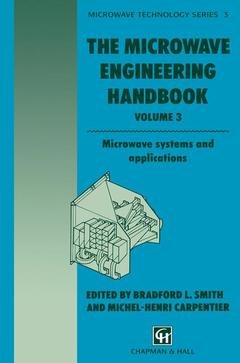Description
The Microwave Engineering Handbook, 1993
Microwave systems and applications
Microwave and RF Techniques and Applications Series, Vol. 3
Authors: Smith B., Carpentier M.H.
Language: English
Subject for The Microwave Engineering Handbook:
Keywords
Apertur; Maser; Transmission; imaging; interferometry; laser; television
Publication date: 01-2013
558 p. · 15.5x23.5 cm · Paperback
558 p. · 15.5x23.5 cm · Paperback
Description
/li>Contents
/li>
The Microwave Engineering Handbook provides the only complete reference available on microwave engineering. The three volumes of the handbook cover the entire field of microwave engineering, from basic components to system design. All entries in the handbook are written by experts in the area, bringing together an unrivalled collection of expertise on microwave technology. Volume 3: Microwave systems and applications provides a thorough introduction to the principal applications of microwave technology. Telecommunication, broadcasting, detection and ranging and scientific and industrial applications are covered with appendices on microwave measurement and frequency allocation. This volume shows the range of current and developing applications for microwave technology and will enable readers to appreciate the variety of applications and the requirements for the various system types.
1 Point-to-point transmission, terrestrial line-of-sight links, terrestrial troposcatter links.- 1.1 General.- 1.2 Principles of radio relays.- 1.3 Analogue microwave links.- 1.4 Digital microwave links.- 1.5 Specific nature of over-the-horizon microwave links.- References.- 2 Satellite links.- 2.1 General.- 2.2 Basic principles.- 2.3 Communication satellite technology.- 2.4 Earth stations.- 2.5 Conclusions and prospects.- References.- 3 Low and medium power translators and transmitters.- 3.1 Optimization of the input design of a television translator.- 3.2 Development of television transmitter modulation stages.- 3.3 Optimization of the output design of a television transmitter or translator and enhancing the level of transistorization.- 3.4 Conclusion.- Appendix 3.A The frequency spectrum and broadcasting channels.- 4 Radar systems.- 4.1 The history of radar.- 4.2 General description of radar systems.- 4.3 Main applications of radar systems.- 4.4 Expected evolution of radar systems.- References.- 5 Electronic confrontation.- 5.1 Introduction.- 5.2 Electronic support measures (ESM).- 5.3 Electronic countermeasures (ECM).- 5.4 ECCM applied to radio frequency links.- 5.5 ECCM applied to radars.- 5.6 System design methodology.- 6 Infrared.- 6.1 Introduction.- 6.2 Short historical background.- 6.3 Theory notes.- 6.4 Infrared techniques.- 6.5 Military applications of infrared.- 6.6 Developments and trends in the infrared field.- 7 Industrial, scientific and medical (ISM) applications of microwaves present and prospective.- 7.1 Introduction.- 7.2 High power applications.- 7.3 Active sensors and systems.- 7.4 Passive sensors and systems.- 7.5 Conclusion.- References.- 8 Radioastronomy.- 8.1 Introduction.- 8.2 Radio telescopes.- 8.3 Cosmic radio emission.- 8.4 Continuum radiosources.- 8.5 The 21 cm hydrogen line.- 8.6 Interstellar molecules.- 8.7 Conclusion and prospects.- Appendix 8.A Units and constants in astronomy.- References.- Problems.
© 2024 LAVOISIER S.A.S.
These books may interest you

Power Vacuum Tubes HandbookHand Book 293.12 €

Power Vacuum Tubes HandbookHand Book 117.69 €


